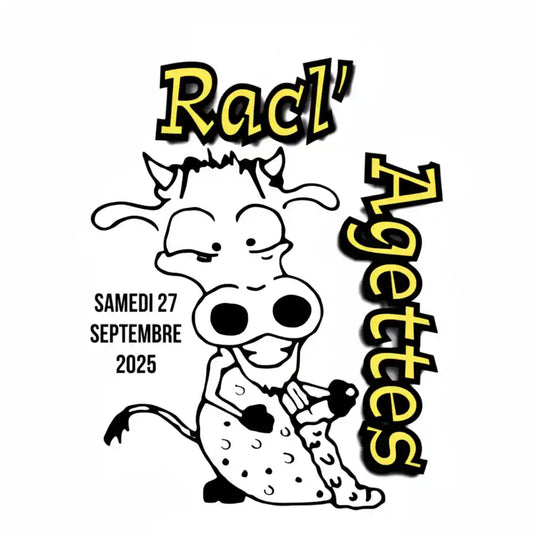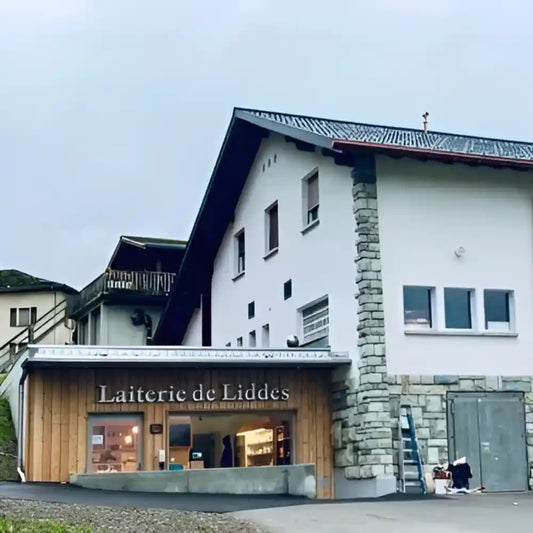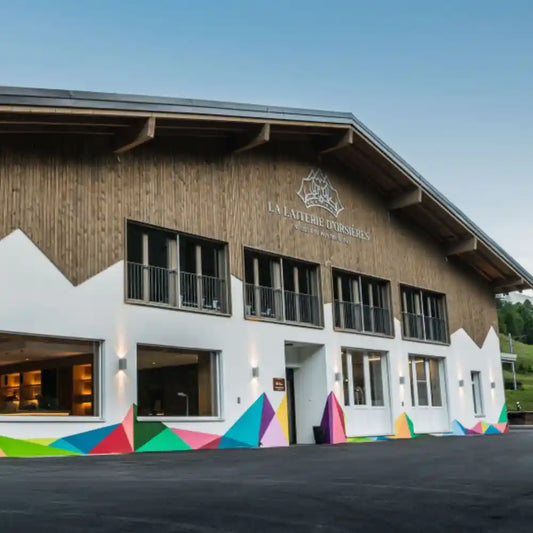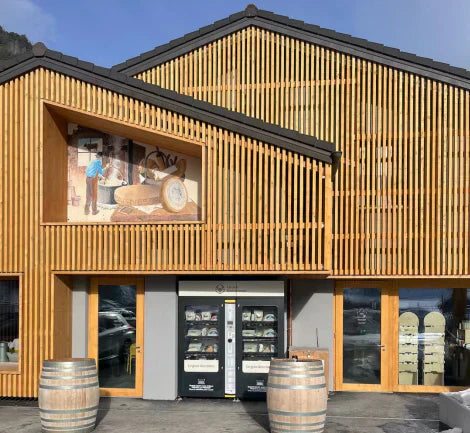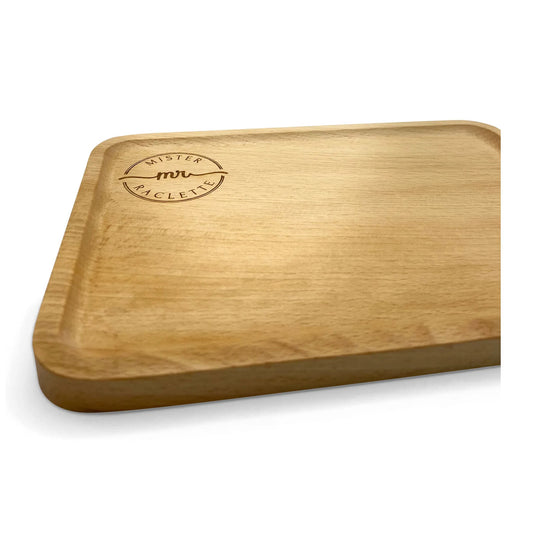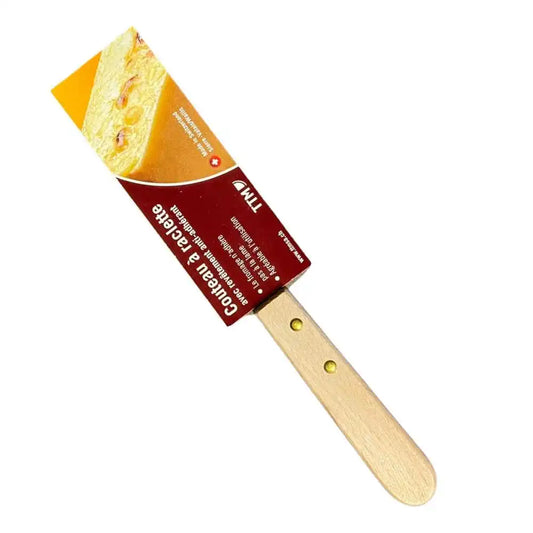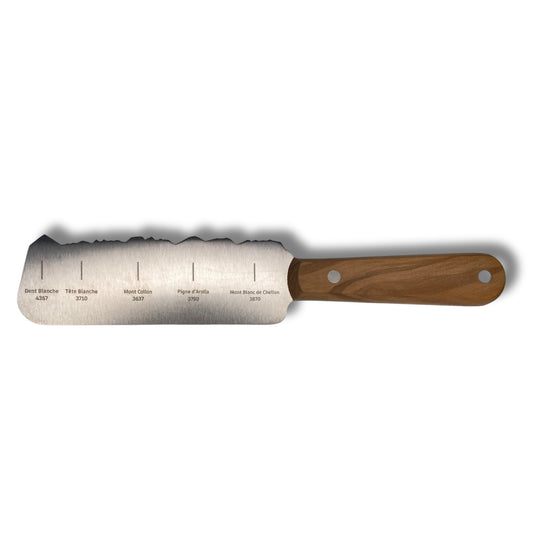What is the origin of raclette?
The origin of Valais raclette
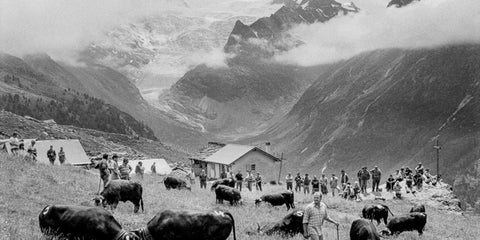
Let's dive into history and let the origins of raclette guide us through the picturesque mountains of Valais in Switzerland. This now-popular dish has its roots in ancient writings that, surprisingly, take us back to the 16th century. According to a Wikipedia article.
The story of Gaspard Ambuel
Among the prominent figures of Valais, Gaspard Ambuel, better known by his pseudonym Collinus, stands out as one of the first witnesses to this rich cheesemaking tradition. He practiced his talents in Sion as a physician and pharmacist. Ambuel contributed a notable work in 1574. Entitled "Vallesiae descritpio," a work by Josias Simler of Zurich. In a gesture of dedication, Ambuel addressed his pages to Conrad Gessner, a renowned naturalist and botanist. He counted the famous Erasmus among his friends. To give greater depth to his text, Ambuel was able to draw on the historical knowledge of Hildbrand I of Riedmatten, who held the episcopal see of Sion from 1565 to 1604.
The Publication in Zurich
This document was printed by Christophe Froschauer in Zurich. The Valais historian Dionys Imesch, who held several positions, including professor at the Brig College, parish priest in Naters, and president of the Upper Valais Historical Society, speaks highly of Ambuel. He emphasizes that Ambuel was not only a renowned Swiss scholar of his time, but also a key informant for Conrad Gessner and Erasmus, providing them with scientific information on the Valais.
An ancient testimony on the origin of raclette
In the Bologna edition, a Latin passage takes us on a journey through time, plunging us directly into daily life in 16th-century Valais. When we examine its translation, this excerpt reveals a picturesque scene. The people of Valais assiduously gather at a place called "Augstport." Surprisingly, despite the obvious absence of robust trees in these places, they found a way to light a fire under a stone. They cleverly exploited rhododendrons. Gathered around this source of heat , these inhabitants made themselves comfortable. They unpacked provisions from their bags and devoted themselves to the art of melting cheese. These delicacies, according to the description, were distinguished by an exceptional flavor, combining fat, sweetness, and tenderness.
The Augstbord Pass and the origin of raclette
Collinus, in his writings, refers to a unique tradition of the Valaisans. During their visits to the cold healing springs of Augstbord, located near Grächen , they used to roast cheese. Afterwards, they would eat it while sipping cold water, even beyond the tree line. This practice was intrinsically linked to the Augstbord Pass, a passage frequented by muleteers on their way to Saint Nicholas in Meiden, nestled in the Turtmann valley. It is in the heart of this mountainous landscape that the origins of raclette are revealed. Thus, we are immersed in the captivating traditions of 16th-century Valais.

Origin of Valais raclette
Origin of Raclette in the 16th century
Raclette, a traditional Swiss dish, has deep historical roots and is no myth. Grégoire Ghika, an expert on the subject, detailed in the newspaper 13 Etoiles the ancient practice of melting cheese, particularly old hard and soft cheeses, and dousing them with spring water. These cheeses were so delicious that they couldn't get enough of them. Although the Valais wine, Fendant, is now the drink of choice during raclette evenings, there was once a particular interest in Augstbord water, considered miraculous. Ghika wonders about the contents of the "little gourds" that the Valaisans brought with them.
Raclette in the 18th century and its origins
During the 18th century, there was an increase in written references to cheese. For example, in 1768, Abbé Clément, during his observations in Mase in Valais, highlighted a marked preference for roasted full-fat cheese. Particularly during meals containing meat. Then, towards the beginning of the 19th century, Hildbrand Arnold Schiner, a scholar and notable from the canton of Valais, detailed the eating habits of the people of Valais in his work on the Simplon department. He mentions that in Anniviers, roasted cheese occupied a central place at funeral meals. Moreover, in Savièse, this dish was traditionally on the menu at wedding meals. Beyond these examples, Schiner provides numerous other references illustrating the importance of cheese in Valais culture.
Evolution of raclette in the 19th century
As the 19th century progressed, the term "raclette" began to appear in writings about the Valais. This word, originating from the Franco-Provençal dialect, means "to scrape" in the Valais dialect. Although travelers observed the practice of raclette during their visits, the gastronomic dish itself was not yet called "raclette." Later, this derivative of the verb was written with a circumflex accent (Râclette), reflecting its dialectal pronunciation.
Traditional practices
According to the stories of the ancient Valaisans, the preparation of raclette involved a very specific ritual. Armed with a simple piece of wood, the shepherds would expose half a tomme of cheese to the burning embers of a wood fire. Then, when the autumn frosts set in, they would delicately scrape the melted cheese and place it on a piece of crusty bread. For these shepherds, this method of preparation was not only practical, but it also offered a delicious way to enjoy cheese in the great outdoors and with family.
Eugène Rambert , a central figure in 19th-century French-speaking literature, played a crucial role in associating the term "raclette" with the culinary practice we are familiar with today. Not only was he an art critic, historian, poet, and philosopher, Rambert was also an undisputed lover of the mountains, as evidenced by the Rambert Hut located above Ovronnaz, which is dedicated to him.
In his writings, Rambert evokes a popular trip among intellectuals and artists of his time: a visit to Les Mayens-de-Sion. This resort was a popular destination for tourists, especially at the turn of the 20th century. The writer describes the daily routine of a city dweller vacationing there, emphasizing the importance of summer activities, especially outdoor picnics. These rural outings were the perfect opportunity to enjoy raclette, as evidenced by his statement: "We attended two of these joyful picnics: two in four days! It must be said that it was the time of raclette."
The vivid description
Rambert's description of the preparation of raclette is a true delight for anyone who reads his words. According to him, it all begins with a careful selection of cheese, fresh from the mountain, which should ideally be fatty and perfectly ripened. Once this choice is made, the cheese is carefully cut in half and placed in front of a blazing fire, until it reaches a golden color and a texture that is both soft and bubbly.
The crucial moment
As the atmosphere builds with anticipation, the crucial moment arrives: meticulously scraping the melted cheese with a knife, the iconic gesture that gives "raclette" its name. According to Rambert, to fully experience this culinary experience, one must be outdoors, surrounded by warm friends, and complemented by a light, sparkling wine. He describes an idyllic atmosphere where one can easily imagine a joyful group, comfortably seated in the shade of the larches. The most skilled take charge of the cooking, while a devoted young woman serves the wine.
A true Valais raclette experience
Rambert also insists that the true raclette experience is intrinsically linked to its place of origin, Valais. More specifically, he refers to Mayens-de-Sion, a high-altitude location near Sion. For him, enjoying a Valais raclette anywhere other than this picturesque setting would be like wearing inappropriate clothing for the occasion.
Moreover, the term "raclette" was not only mentioned by Rambert. From the end of the 19th century, several Valais publications regularly mentioned raclette. For example, in 1875, the newspaper "Le Villageois," published by an agricultural society in Sion, referred to raclette in the context of a recipe similar to fondue. This early mention shows that raclette was already well established in the culinary culture of Valais at that time.
In short, Eugène Rambert, through his writings, contributed greatly to the popularization of Valais raclette. He captured the essence of this delicious dish and the ideal context for its enjoyment. Thanks to figures like him, raclette is today much more than just a dish; it is a symbol of conviviality, tradition, and regional identity.
Raclette: At the heart of Valais stories
Raclette, a dish both warm and traditional, has always carved out a special place for itself in Valais culture. Indeed, numerous anecdotes and historical accounts corroborate this claim, highlighting its undeniable popularity and its deep, unshakeable roots in Switzerland's rich heritage.
The "Friend of the People" and his allusions to raclette
The newspaper "Ami du peuple" describes an intriguing situation regarding the pupil chamber of a Valais commune. Apparently, its members were demanding bread, wine, and cheese in addition to their fees. Moreover, no one challenged them to legally justify such a request. This episode shows how local actors integrated and perhaps even exploited raclette, highlighting its importance far beyond a simple festive table.
A tradition well established before 1880
In 1880, a memorable turning point occurred in the culinary history of Valais. At that time, eight Valais notaries, wishing to celebrate their success, chose to gather at the Café de la Glacière in Sion. There, they had the pleasure of enjoying an authentic raclette. This evening, still vivid in people's minds, was punctuated by toasts, heated discussions, and lively melodies, all extolling the unparalleled flavor of this dish. Moreover, the use of the word "traditional" to describe raclette is a testament, beyond a shadow of a doubt, to the antiquity of this culinary tradition. Indeed, its fame was so great that several establishments in Sion had incorporated it into their menus, as evidenced by advertisements from the time.
Celebrities and Raclette: Precious Testimonies
The importance of raclette wasn't limited to the inhabitants of Valais. Many famous people spoke about it or experienced it during their visits to the region. Victor Hugo, for example, enjoyed raclette in Champéry in 1883, leaving his signature in the guestbook of the Valais Drinkers. This testimony illustrates the universal appeal of this dish.
The Picturesque Writings of Victor Tissot
In 1888, a significant event occurred when Victor Tissot, a renowned journalist, passionately illustrated a raclette scene in the Torrent mountain pasture in the Val d'Anniviers. Through Tissot's pen, we are transported to the scene, almost feeling the heat of the embers and being captivated by the irresistible aroma of melted cheese. He is not satisfied with this; his meticulous description, from the process of preparing the cheese to the moment of tasting, highlights the authenticity and charm of this ancestral tradition throughout the world. Moreover, throughout his writings, Tissot does not hide his impatience and enthusiasm for this dish, perfectly illustrating the impact and notoriety of raclette within Swiss culture.
Origin and evolution of Valais raclette
1. A look back at the past: Louis Courthion and Valais cheese
Louis Courthion, a writer and journalist from Bagnes, Valais, describes the art of raclette in his 1903 book "Le peuple du Valais." According to him, raclette is a technique that involves melting half a wheel of cheese over a fire and serving it to guests. He notes that cheeses from Conches and Bagnes are particularly popular for this practice.
2. Raclette through literature and cuisine
Louis Courthion isn't the only one to mention raclette. Joseph Favre, famous for his contribution to French cuisine in the 19th century, describes a fatty cheese produced in the Hérens Valley in Valais that resembles raclette cheese. His major work, "The Universal Dictionary of Cuisine," also tends to mention it. Furthermore, the Geographical Dictionary of Switzerland links fatty cheese to the dish raclette.
3. Raclette and the influence of village dairies
With the emergence of village dairies in the early 20th century, raclette became more accessible to the population. These dairies, called "fruitières" in Valais, helped make raclette a national dish.
4. Raclette as a national dish: The 1909 cantonal exhibition
Raclette officially became a Valais national dish at the Sion Cantonal Exhibition in 1909. During this event, a raclette evening was organized for the press, introducing the dish to a wide audience. The event was a great success and marked the history of raclette.
The Origin of Raclette: Evolution Through the Years
The beginning of raclette's popularity
From the 1920s onwards, raclette became known beyond its origins. It quickly became popular. At the Buffet de la Gare in Sion, it was a must-try. In 1935, a photo captured a tasting at the Château de Valère, demonstrating its importance in local culture. In 1928, at the Sierre Cantonal Exhibition, raclette stood out. It was not only on the menu, but also at the heart of the procession.
This piece of cheese: a story rich in taste
Raclette, recognized above all for its unparalleled flavor, also hides a rich and fascinating history. To illustrate this, let's go back to 1934, in Savièse. It was during this unique event, the blessing of the church cemetery, that raclette and potatoes were propelled to the forefront. This episode, in fact, highlights its undeniable cultural importance in the region. Continuing this momentum, and moving forward a year, in 1935, the Montana Women's Mountaineers Club chose to stop in Sion. Driven by their greed, they let themselves be guided to Miss Héritier's restaurant in Granois/Savièse. Once there, the excitement of savoring raclette was at its peak. And, unsurprisingly, the dishes served were quickly devoured, creating a joyful and festive atmosphere.
Raclette is gaining in fame
Over the years, raclette gained in notoriety. Thus, in 1964, a significant event occurred in Lausanne: a float dedicated to raclette appeared. The result of the ingenuity of Mr. Zufferey of the Cantonal School of Agriculture, this initiative unequivocally demonstrates the importance and value of raclette in the heart of Valais.
Raclette and the dairy industry
Raclette has a prominent place in Valais. But it is also linked to the dairy industry. In 1919, delegates from the municipalities met. They created a milk federation. Their goal was simple: a fair price for milk. They were responding to a problem: Valais was the only canton without a dairy federation. The war had also revealed gaps. As a result, the municipalities created dairies.
The evolution of the dairy sector and AOP raclette
Over the years, the dairy industry has undergone profound changes. As proof, in 1945, Sion witnessed the emergence of a new entity: the Central Purchasing Agency for Valais Cheese. This organization distinguished itself by its impressive cheese sales. Then, moving forward in time, more precisely in 1988, an innovative initiative was born with the creation of a cooperative called Alpgold. The latter, surpassing the capacities of the central purchasing agency, took charge of nearly 1,000 tons of Valais cheese annually. Although these structures embody a certain modernity, production remains rooted in tradition. Raclette, a symbol of this authenticity, is still carefully prepared in 37 cheese dairies and 138 mountain pastures, and would become Raclette du Valais AOP a few years later. To mention Valais is to mention Raclette du Valais AOP. And that's a good thing, because its ambassador, Eddy Baillifard, is inexhaustible on the subject. Come take a look at the online store and the cheese portal Misterraclette.ch and discover the codes and the 11 commandments of the cheese scraper.
What is the country of origin of raclette?
Raclette originated in Switzerland, more specifically in the canton of Valais. It was in this region that raclette, as the term for raclette, truly took off and became a culinary tradition. Making raclette cheese is an art passed down from generation to generation, making Valais the birthplace of this iconic dish. Raclette evenings celebrate not only the cheese but also an entire cultural heritage. This is why, in Switzerland, raclette is much more than just a meal; it's a true celebration that brings family and friends together around the table.
Is raclette French?
Although raclette is often eaten in France, especially on cold winter evenings, it is not native to this country. Raclette, as we know it today, comes from the canton of Valais in Switzerland. However, the popularity of raclette in France has led to the dish being adopted and enjoyed by the French, to the point where some might think it is a local specialty. In France, it is not uncommon to see raclette evenings organized every week, featuring raclette cheese, charcuterie, and potatoes, creating a warm and friendly atmosphere.
Who is the creator of raclette?
Raclette has no single creator, but it stems from a long cheesemaking tradition in the canton of Valais. The term raclette comes from the French word "racler," which means "to scrape," referring to the act of scraping melted cheese onto potatoes. This practice dates back centuries, when Valais shepherds melted cheese over hot stones. Cheesemaking was already well established at the time, and it was this expertise that led to the development of Raclette cheese as we know it today. The dish has become so popular that it is now eaten in several countries.
Which country eats raclette?
Raclette is primarily consumed in Switzerland and France, but its popularity has spread far beyond these borders. Indeed, many European countries, such as Germany and Austria, have adopted raclette for their convivial evenings. Even beyond Europe, raclette finds fans, particularly in Canada and the United States, where harsh winters invite this kind of comforting meal. On our site, you can discover how raclette became a dish loved around the world and why it so perfectly embodies the spirit of sharing and conviviality.
Our selection of raclette cheeses and accessories for a raclette evening!
At Misterraclette, we are passionate about quality food and authenticity. Our selection of raclette cheeses , including authentic Raclette du Valais AOP, guarantees you an exceptional taste experience. We also offer a complete range of raclette machines and accessories every week to make your evenings unforgettable. Feel free to view the cheese portal on various online pages. However, you will not find raclette slices with us.

